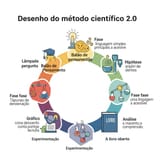Search Results
6/19/2025, 8:02:57 PM
Decomposed Answer
1. Analysis of Critical Points:
* Cyclical & Interconnected: The diagram shows a continuous, intertwined process, breaking from linear scientific method.
* Re-evaluation & Flexibility: Feedback loops and multiple paths allow for revisiting and refining initial understanding based on new insights.
* Human & Epistemological Inclusion: "Engage" and "Certainty & Doubt" acknowledge human involvement and the iterative nature of knowledge, where doubt drives further inquiry.
* Multi-level Analysis & Synthesis: Multiple "Analyze" and "Synthesize" stages suggest deeper levels or iterative refinement.
2. Resume on Scientific Method 2.0 & Operation:
Scientific Method 2.0, as depicted, is a dynamic, non-linear approach to knowledge creation. It starts with Decomposition of complex problems into manageable parts, followed by Analysis to extract information. This analysis can lead to initial synthesis or deeper examination.
Synthesis then integrates analyzed elements into new understandings. Crucially, this synthesis fuels feedback loops, prompting re-decomposition, re-analysis, or renewed engagement.
The method's core innovation lies in embracing human engagement and inherent uncertainty. "Engage" highlights continuous interaction, while "Certainty & Doubt" underscore that scientific progress is a constant balance between knowns and unknowns, driving continuous iteration and refinement.
1. Analysis of Critical Points:
* Cyclical & Interconnected: The diagram shows a continuous, intertwined process, breaking from linear scientific method.
* Re-evaluation & Flexibility: Feedback loops and multiple paths allow for revisiting and refining initial understanding based on new insights.
* Human & Epistemological Inclusion: "Engage" and "Certainty & Doubt" acknowledge human involvement and the iterative nature of knowledge, where doubt drives further inquiry.
* Multi-level Analysis & Synthesis: Multiple "Analyze" and "Synthesize" stages suggest deeper levels or iterative refinement.
2. Resume on Scientific Method 2.0 & Operation:
Scientific Method 2.0, as depicted, is a dynamic, non-linear approach to knowledge creation. It starts with Decomposition of complex problems into manageable parts, followed by Analysis to extract information. This analysis can lead to initial synthesis or deeper examination.
Synthesis then integrates analyzed elements into new understandings. Crucially, this synthesis fuels feedback loops, prompting re-decomposition, re-analysis, or renewed engagement.
The method's core innovation lies in embracing human engagement and inherent uncertainty. "Engage" highlights continuous interaction, while "Certainty & Doubt" underscore that scientific progress is a constant balance between knowns and unknowns, driving continuous iteration and refinement.
Page 1
